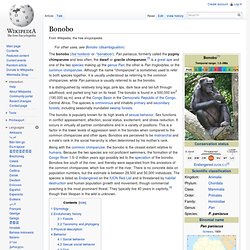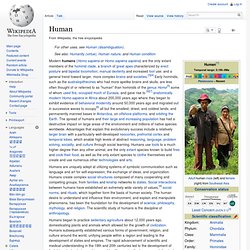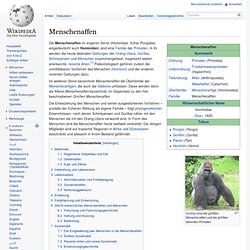

8,000-year-old mutation key to human life at high altitudes: Study identifies genetic basis for Tibetan adaptation. Timeline of human evolution. Bonobo. The bonobo (/bəˈnoʊboʊ/ or /ˈbɒnəboʊ/), Pan paniscus, formerly called the pygmy chimpanzee and less often, the dwarf or gracile chimpanzee,[3] is a great ape and one of the two species making up the genus Pan; the other is Pan troglodytes, or the common chimpanzee.

Although the name "chimpanzee" is sometimes used to refer to both species together, it is usually understood as referring to the common chimpanzee, while Pan paniscus is usually referred to as the bonobo. It is distinguished by relatively long legs, pink lips, dark face and tail-tuft through adulthood, and parted long hair on its head. The bonobo is found in a 500,000 km2 (190,000 sq mi) area of the Congo Basin in the Democratic Republic of the Congo, Central Africa. The species is omnivorous and inhabits primary and secondary forests, including seasonally inundated swamp forests. The bonobo is popularly known for its high levels of sexual behavior. Etymology[edit] Evolutionary history[edit] Fossils[edit] Female bonobo Diet[edit] Human. Humans began to practice sedentary agriculture about 12,000 years ago, domesticating plants and animals which allowed for the growth of civilization.

Humans subsequently established various forms of government, religion, and culture around the world, unifying people within a region and leading to the development of states and empires. The rapid advancement of scientific and medical understanding in the 19th and 20th centuries led to the development of fuel-driven technologies and improved health, causing the human population to rise exponentially.
By 2012 the global human population was estimated to be around 7 billion.[10][11] Etymology and definition In common usage, the word "human" generally refers to the only extant species of the genus Homo — anatomically and behaviorally modern Homo sapiens. In scientific terms, the definition of "human" has changed with the discovery and study of the fossil ancestors of modern humans. History Evolution and range Evidence from molecular biology.
Human evolution. Human evolution is the evolutionary process leading up to the appearance of modern humans.

While it began with the last common ancestor of all life, the topic usually covers only the evolutionary history of primates, in particular the genus Homo, and the emergence of Homo sapiens as a distinct species of hominids (or "great apes"). The study of human evolution involves many scientific disciplines, including physical anthropology, primatology, archaeology, ethology, linguistics, evolutionary psychology, embryology and genetics.[1] The earliest documented members of the genus Homo are Homo habilis which evolved around 2.3 million years ago; the earliest species for which there is positive evidence of use of stone tools.
The brains of these early hominins were about the same size as that of a chimpanzee, although it has been suggested that this was the time in which the human SRGAP2 gene doubled, producing a more rapid wiring of the frontal cortex. History of study[edit] Before Darwin[edit] Menschenaffen. Gorillas sind die größten Menschenaffen und die größten lebenden Primaten Im weiteren Sinne bezeichnet Menschenaffen die Überfamilie der Menschenartigen, die auch die Gibbons umfassen.

Diese werden dann als Kleine Menschenaffen bezeichnet, im Gegensatz zu den hier beschriebenen Großen Menschenaffen. Die Einbeziehung des Menschen und seiner ausgestorbenen Vorfahren – anstelle der früheren Stellung als eigene Familie – folgt phylogenetischen Erkenntnissen, nach denen Schimpansen und Gorillas näher mit den Menschen als mit den Orang-Utans verwandt sind. In Form des Menschen sind die Menschenaffen heute weltweit verbreitet. Die übrigen Mitglieder sind auf tropische Regionen in Afrika und Südostasien beschränkt und allesamt in ihrem Bestand gefährdet. Merkmale[Bearbeiten] Allgemeiner Körperbau und Fell[Bearbeiten] Das Fell ist weniger dicht als bei anderen Primatenarten, es ist bei Orang-Utans rötlichbraun und bei Gorillas und Schimpansen schwarzbraun gefärbt.
Gliedmaßen[Bearbeiten]